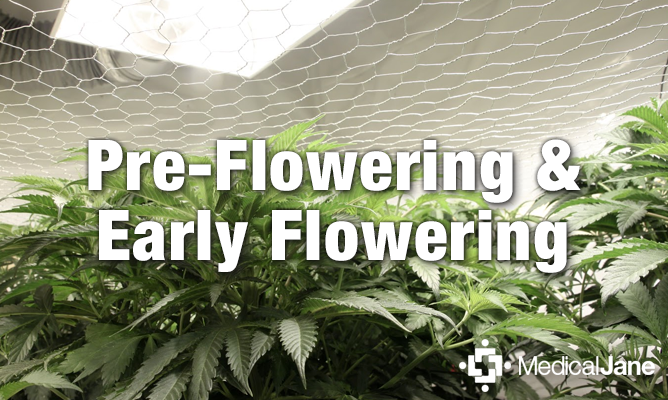
Pre-Flowering and Early Flowering Tips For Growing Cannabis Indoors
Last time in our home growing series here at Medical Jane, we discussed pre-veg and vegetative growth for cultivating medicinal cannabis indoors successfully. Some of the things we talked about included knowing how much space to leave for growth once flowering begins and what kind of spacing and plant numbers a grower might need to achieve their desired yield levels with the strain(s) selected.
Pre-flowering Tips And Tricks For Growing Indoors
If you started your plants from seed, your crop may be showing you signs of pre-flowering. Once most strains reach a certain level maturity or size in veg, they often show some sings that they want to enter the reproductive phase. Take advantage if you used regular seeds (a great choice), because you can use this opportunity to identify and males plants and remove them from the garden. Even just a small release of pollen early on can lead to seeds later on. Growing medicine is one thing, growing for seed breeding purposes is another. More on that later.
 If you started your crop from cuttings of cloned plants, it’s much easier to gauge how long to grow them before budding, because they are of known genetics. However, environmental and fertility differences as well as management can have some bearing on how much the plants will grow after budding has started, genetics aside.
If you started your crop from cuttings of cloned plants, it’s much easier to gauge how long to grow them before budding, because they are of known genetics. However, environmental and fertility differences as well as management can have some bearing on how much the plants will grow after budding has started, genetics aside.
For example if you keep Carbon Dioxide levels at ambient during Veg, and apply supplemental CO2 during the bud phase (especially early on), you can expect to see a significant surge in growth and stature — within the reach of your genetic selection, naturally.
Light levels do not need to be exceptionally strong for crops to benefit from supplemental CO2. Commercial greenhouse growers have long been applying supplemental CO2 during winter months with lower light levels in order to stimulate and maintain higher levels of production and faster growth rates in lowered light conditions.
How much space you have for roots is also a factor leading up to this point and beyond. Transplanting during budding is usually not a good idea; the shock hurts yield potential. Avoid transplanting at least a few days before budding begins.
If you vegged under lower light intensities versus what plants will get for the budding phase, for example starting under T-5s and budding under HPS lighting, it’s wise to get plants accustomed to higher intensities and a drastic change in spectrum before budding begins.
The same holds true for ventilation. If your veg plants received less air movement and more humid conditions during veg, they could be in a for a shock moving into a more intensive environment-so that’s not the time to start budding, as the shock cuts into the time of the window of opportunity for creating your potential yield and crop quality at harvest.
If at all possible, give indoor grown marijuana plants at least a few days at 18/6 lighting in the types of conditions they will be budding in so they have some time to adjust before you make “The Flip” into the budding cycle by changing the lighting cycle to 12 hours on and 12 hours off (uninterrupted darkness).

Here are some things you can do to get your crop primed and ready to create a stronger and more prolific flowering response once you decide to initiate the budding phase (or with auto-flower strains, they will do it themselves, regardless of day length):
- If you grow your plants in soil or soilless mediums, you can add a small amount of carbohydrates in along with your regular crop feeding program. When Nitrogen is reduced at the start of flowering, this can help lessen stretching, keep growth tight and efficient under grow lights.
- Soil and soilless grown crops take longer to exhibit changes in fertility levels to the plant once growers start transitioning their crop feeding program. Hydroponic grown crops can demonstrate responses to a change in the nutrient solution in hours, rather than days. So, if you grow soil or soilless, you might start adding a small ratio of bloom fertilizer early on-just before flowering. In hydroponics, you might run your veg food a few days into flowering, before starting to transition to your base nutrients for budding.
- Discontinue use of B-Vitamin supplements during the transition to bloom; your plant will show a stronger response to the change in light duration, ie budding faster and more intensely sooner.
- Supplying microbial products in soil or soilless gardens can help grow more roots to support bigger buds while helping to protect root systems against increasing salinity over the duration of crop fertilizer applications to harvest.
- DON’T over-apply lighting intensities. Keep HID lamps a respectable distance from the tops of plants. Too much light will hurt growth and likely create calcium deficiencies in the early bud phase.
- DO Add more calcium to the nutrient solution in hydroponics and soil growing methods; additions of fulvic acids will further help improve gains in the early bud and pre flowering phase.
Important Note: A lot of growers start to treat their plants to budding conditions as soon as they flip the lighting cycle to 12/12. Often growers see more growth gain, which means more budding sites, and healthier crops when they transition their plants through pre-flowering into budding. Normally, it takes from 7 to 14 days for plants to show signs of flower and bud development once the critical lighting cycle has been set. Just like we talked about with regard to pre-veg when transitioning from propagation to vegetative growth conditions.

Experienced growers know that a smooth transition lends well to better yields later-with fewer chances of problems in between.
As a final thought, it’s better to rid your crop of any problems BEFORE you start budding, even if it means a delay of a week or two, for example ridding your crop of an insect attack or a nutrient deficiency. You can always prune, bend or tie plants to conserve space if you need to—the most important part is to ensure your soon to be budding cannabis plants are in the prime of their health before charging across the starting line to towards the harvest at the end of the bud phase.
If possible, keep light/dark temperatures close, ie. a narrow differential during the onset of flowering; it’s a natural way to keep growth tighter and helps prevent spikes in humidity once the lights shut off.
Erik Biksa has been writing about and discussing hydroponics growing, related technologies and cropping methods since 1999 in a variety of professional publications and platforms globally Erik has travelled the world learning and teaching modern …
